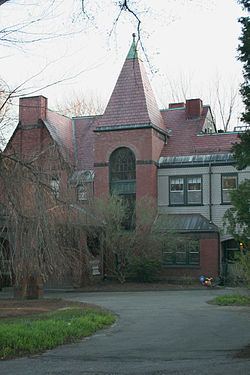Built 1883-1884 Opened 1884 | NRHP Reference # 86001771 Added to NRHP 4 October 1986 | |
 | ||
Location 16 Fairmont Avenue, Newtonville, Massachusetts | ||
All about bayley house
The Bayley House is a historic house at 16 Fairmont Avenue in Newtonville, Massachusetts. Built in 1883-84, it is a prominent example of Ruskinian Gothic architecture, designed by the noted firm of Peabody and Stearns. It was listed on the National Register of Historic Places in 1986.
Contents
Bayley house search
Description
The Bayley House stands in a residential area roughly midway between the villages of Newtonville and Newton Corner, on the south side of Fairmount Street, a short way west of its junction with Centre Street. The house was originally oriented to face Centre Street, but after intervening development was reoriented to face Fairmount Street to the north. It is a large 2-1/2 story building, built of brick, freestone, red slate, and wood. It has irregular and asymmetric massing typical of the Queen Anne period, including a tower with steeply pitched pyramidal roof at one corner. Its main gables are adorned with stucco and half-timbering. A single-story porch extends around parts of the building, with Union Jack balustrades; a porte-cochere provides access to the main entrance via a semicircular drive. The landscape design of the property is said to have been done by William Manning, working for Frederick Law Olmsted.
History
The Bayley House was designed and built in 1883-84 by the Boston-based architectural firm of Peabody and Stearns, noted for its commercial and residential architecture in the late 19th century. The house was commissioned by James C. Bayley, a Boston shoe merchant who died within months after ground was broken in late 1883. Bayley's widow, Martha R. Bayley, oversaw the completion of the house, but she and her young children never moved in.
The first occupants of the house were the family of Cyrus Anderson, who lived there from 1884 to 1897. Subsequent owners were the Luther Adams family (wife Lizzie), from 1897 through approximately 1901. Adams was a wine merchant in Boston. Also residing with them were daughters Fanny M. and Mabel Adams. Luther Adams died in 1901 at age 68. The house was occupied by Mr. and Mrs. Edgar P. Van Etten (President, Boston and Albany Railroad) in 1903.
From approximately 1905 to approximately 1919, the home was owned by the Charles H. Breck family who formerly lived at 62 Bellevue Street in Newton. Breck was in the agricultural tools business at 51 North Market in Boston, known as Joseph Breck & Company (now called Breck's, founded by his grandfather Joseph Breck and his father, Charles H.B. Breck). Mrs. Charles H. Breck (Marion A.) was a daughter of Luther Adams. Her sister Fanny also lived here. Other children included Charles H. Breck Jr. and Luther J. Breck.
From 1919 to 1925, the home was owned by the John H. O'Brien family, O'Brien was in the wool business at 619 Atlantic Avenue, Boston; his wife was the former Emma M. Matthews. Their children included Byron H. O'Brien and Arnold N. O'Brien. (Arnold, a coal dealer, was born in Dorchester in 1906 and married Helen F. Priest in Keene, New Hampshire on June 10, 1933.)
From 1931 through 1945, the home was used as the Damon Hall Junior College, run by Frank and Annie Damon. A brochure of the school is at: File:Damon Hall Brochure circa 1943.pdf
A private family (John Ronne, an attorney) lived in the home again from 1948 until approximately 1963.
From 1964 through 1984, the home was owned by the religious order of Stigmatine Fathers, a Catholic religious congregation of priests and brothers. The order also owned the house next door at 36 Fairmont Avenue.
The house is currently in use as a private residence, as it has been since approximately 1984. It was added to the National Register of Historic Places on October 4, 1986.
